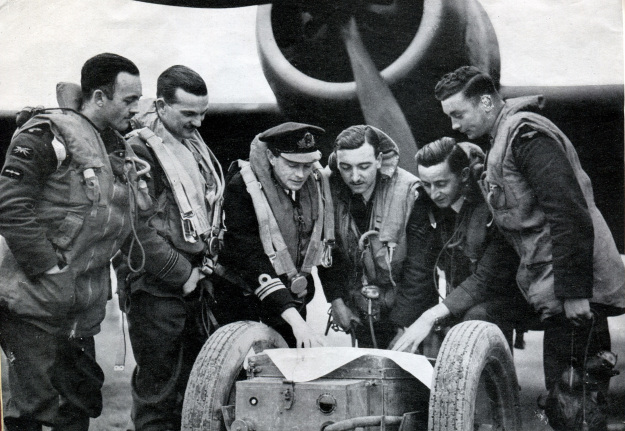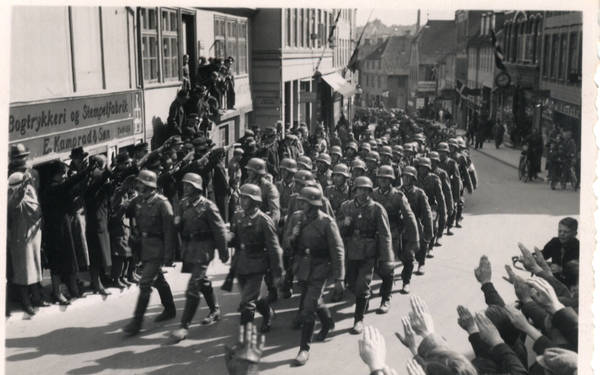Friday 12 April 1940
Norway: Operation Weserubung on 12 April 1940 is proceeding with minimal interference so far from either outside powers or the Norwegian military. Locals are responsible for quartering Wehrmacht troops, and, as usual, the German government pays for their billets in Reichsmarks.
The Norwegian government admits in a communique to losing Oslo, Kristiansand, Stavanger, Bergen, Agdense, Trondheim and the Vaernes military base. The rest of southern Norway, it claims, remains in Norwegian hands, along with the entirety of northern Norway save Narvik. The government continues to strike a defiant tone, minimizing the extent of the German invasion. The Germans are annoyed at the Norwegians' refusal to acquiesce like the Danes and express this with an air attack against the small town sheltering the King and government, Elverum, around 17: 20.
Elverum is overflowing with refugees who have followed the government there. Journalist Erik Seidenfaden notes that "The hotels are full of ministers huddling 'round stoves and breaking icicles to clean teeth. All the town's stationery has been bought for government business." King Haakon is distressed at the harm he is bringing to the locals by his presence, stating: "I cannot bear to watch children crouching in the snow as bullets mow down trees." He cannot stay there indefinitely, because the Wehrmacht knows exactly where he is.
In fact, the Wehrmacht is starting to move beyond its city bases in southern Norway. They are expanding away from Oslo in all directions, like a mushroom cloud. The 196th Division takes Kongsberg to the southwest of the city, and the 163rd Division takes Moss, Frederickstad, and Sarpsborg.
Norwegian defenses are firming around Trondheim. An artillery officer, Major Hans Holtermann, collects 250 volunteers and occupies a venerable fort at Ingstadkleiva near Trondheim. This will become known as Hegra Fortress. The fort has been out of operation for some time, but it has four 10.5 cm and two 7.5 cm in half-turrets and 4 Krupp m/1887 field guns, along with a storehouse full of ammunition. The Germans nearby notice the sudden activity at the fort, and a Wehrmacht Major comes to request their surrender. Holtermann refuses.
European Air Operations: The RAF sends its largest raid yet, 83-90 bombers (sources vary), to attack Stavanger airfield, but the damage caused is minimal. The RAF loses around ten planes total during the operation.
The Fleet Air Arm bombs Bergen.
Royal Navy carrier HMS Furious launches air attacks against the German 3rd Mountain Division at Narvik.
The New Zealand (No. 75 NZ) Squadron flies long-range reconnaissance from R.A.F. Bassingbourn in northern Scotland over the Lofoten Islands and Narvik. This requires Wellingtons specially fitted with range petrol tanks, and stripped of armour plating, self-sealing tanks and some armament. Everything considered non-essential, including some chairs and oxygen bottles, is removed to save weight. The reconnaissance, which covers over 2,000 miles, is successful. While near Narvik, the crew spots a Luftwaffe Ju 86 apparently performing similar reconnaissance. Nobody really knows what is going on at Narvik, but everybody is quite interested.
Battle of the Atlantic: The Gneisenau, Scharnhorst and Admiral Hipper are moving southwest of Stavanger back to Germany. After RAF reconnaissance spots them, the RAF launches both land- and carrier-based air attacks. None hits the ships, two of which already have been damaged, and they make it back to base.
U-37 (Korvettenkapitän Werner Hartmann) continues its successful patrol by torpedoing and sinking the 4,511 ton British freighter Stancliffe 45 miles northeast of Muckle Flugga, Shetlands at 09:42. There are 16 survivors and 21 perish. The survivors sail their lifeboat to Haroldswick, Unst Island.
British submarine HMS Snapper sinks German cargo ship Moonsund.
The Royal Navy has laid mines in both the Skagerrak and the Kattegat. It also has laid mines from near Holland to near Norway.
Convoy OA 128GF departs from Southend.
Royal Navy destroyers arrive at the Faroe Islands and make preparations for the arrival of British troops.
U-103 is commissioned.
Western Front: France and Britain cancel all leave and order forces to be ready to fight at 6-hours notice.
Denmark: The Faroe Islands agree to accept British protection. No troops arrive yet, though.
Cyprus: The Cyprus Regiment officially is formed.
US Government: President Roosevelt refuses to answer a question about whether the Monroe Doctrine applies to Greenland. He states that the issue is "very, very premature" and "awfully hypothetical."
FDR also answers a question about television, which is still very early in its broadcast history. He opines that it has "a great future," but that there were anti-trust issues which the FCC was working on. NBC currently has the most experience with broadcasting locally in the New York City area.
Australian Homefront: The government bans the sale of foreign magazines and newspapers in order aid the country's balance of trade.
American Homefront: Alfred Hitchcock/David O. Selznick film "Rebecca" premieres in the US. It stars Laurence Olivier and Joan Fontaine. "Dr. Cyclops," a rare technicolor science fiction film of the era, also debuts.
Future History: Herbie Hancock is born in Chicago, Illinois. He becomes famous in the late 1960s for scoring the soundtrack to "Fat Albert and the Cosby Kids" and for a collection of jazz and electronic music albums.
April 1940
April 1, 1940: Weserubung is a GoApril 2, 1940: British Subs On Alert
April 3, 1940: Churchill Consolidates Power
April 4, 1940: Missed the Bus
April 5, 1940: Mig-1 First Flight
April 6, 1940: Troops Sailing to Norway
April 7, 1940: Fleets At Sea
April 8, 1940: HMS Glowworm and Admiral Hipper
April 9, 1940: Invasion of Norway
April 10, 1940: First Battle of Narvik
April 11, 1940: Britain Takes the Faroes
April 12, 1940: Germans Consolidate in Norway
April 13, 1940: 2d Battle of Narvik
April 14, 1940: Battle of Dombås
April 15, 1940: British in Norway
April 16, 1940: Germans Cut Norway in Half
April 17, 1940: Trondheim the Target
April 18, 1940: Norway Declares War
April 19, 1940: Dombås Battle Ends
April 20, 1940: Germans Advancing in Norway
April 21, 1940: First US Military Casualty
April 22, 1940: First British Military Contact with Germans
April 23, 1940: British Retreating in Norway
April 24, 1940: British Bombard Narvik
April 25, 1940: Norwegian Air Battles
April 26, 1940: Norwegian Gold
April 27, 1940: Allies to Evacuate Norway
April 28, 1940: Prepared Piano
April 29, 1940: British at Bodo
April 30, 1940: Clacton-on-Sea Heinkel
2016



No comments:
Post a Comment